Organizational Change Management: Resistance to Change Report
VerifiedAdded on 2023/01/16
|10
|3283
|48
Report
AI Summary
This report synthesizes four articles focused on managing resistance to change within organizations. The first article discusses redesigning digital organizations, emphasizing the need for cultural and strategic alignment to manage change effectively in the digital age. The second article examines resistance to change from a taxonomical perspective, highlighting the importance of understanding individual reactions and psychological factors. The third article presents case studies of General Motors and Nokia, illustrating how organizations can navigate change processes and address resistance. The final article proposes a model for managing change towards environmental sustainability in small and medium enterprises. Each article's summary, critique, and conclusion are provided, offering insights into the complexities of organizational change and strategies for successful implementation.
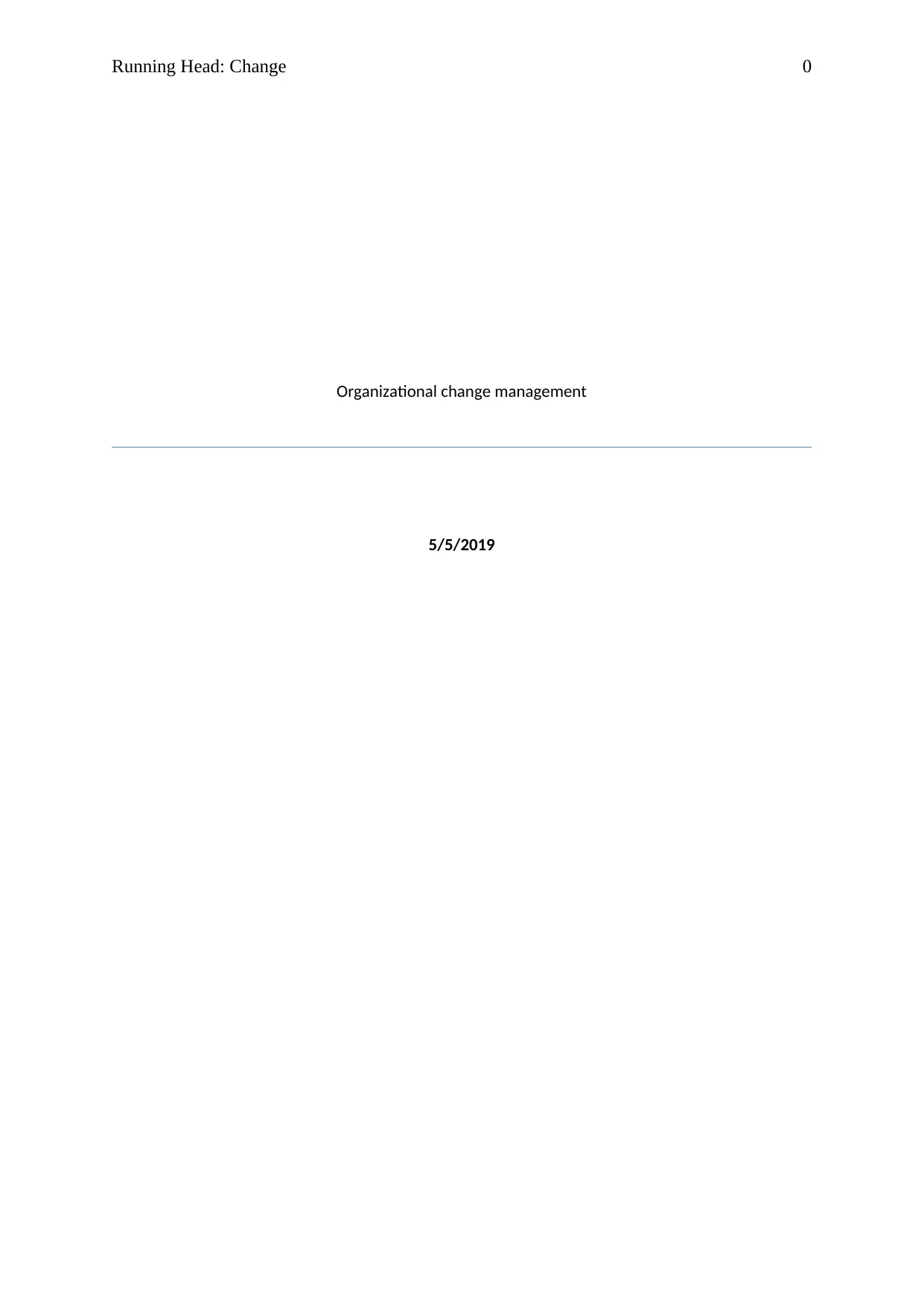
Running Head: Change 0
Organizational change management
5/5/2019
Organizational change management
5/5/2019
Paraphrase This Document
Need a fresh take? Get an instant paraphrase of this document with our AI Paraphraser
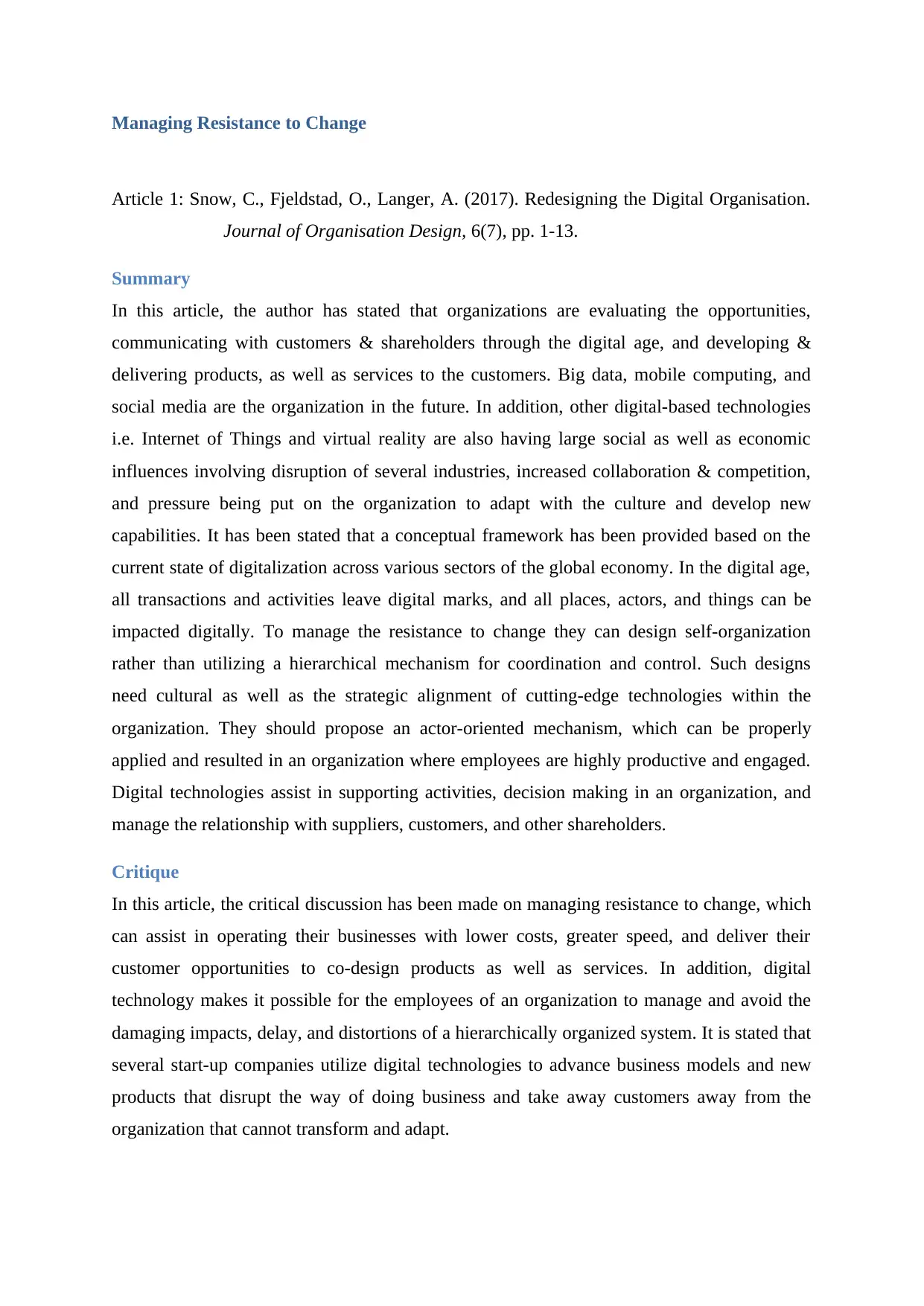
Managing Resistance to Change
Article 1: Snow, C., Fjeldstad, O., Langer, A. (2017). Redesigning the Digital Organisation.
Journal of Organisation Design, 6(7), pp. 1-13.
Summary
In this article, the author has stated that organizations are evaluating the opportunities,
communicating with customers & shareholders through the digital age, and developing &
delivering products, as well as services to the customers. Big data, mobile computing, and
social media are the organization in the future. In addition, other digital-based technologies
i.e. Internet of Things and virtual reality are also having large social as well as economic
influences involving disruption of several industries, increased collaboration & competition,
and pressure being put on the organization to adapt with the culture and develop new
capabilities. It has been stated that a conceptual framework has been provided based on the
current state of digitalization across various sectors of the global economy. In the digital age,
all transactions and activities leave digital marks, and all places, actors, and things can be
impacted digitally. To manage the resistance to change they can design self-organization
rather than utilizing a hierarchical mechanism for coordination and control. Such designs
need cultural as well as the strategic alignment of cutting-edge technologies within the
organization. They should propose an actor-oriented mechanism, which can be properly
applied and resulted in an organization where employees are highly productive and engaged.
Digital technologies assist in supporting activities, decision making in an organization, and
manage the relationship with suppliers, customers, and other shareholders.
Critique
In this article, the critical discussion has been made on managing resistance to change, which
can assist in operating their businesses with lower costs, greater speed, and deliver their
customer opportunities to co-design products as well as services. In addition, digital
technology makes it possible for the employees of an organization to manage and avoid the
damaging impacts, delay, and distortions of a hierarchically organized system. It is stated that
several start-up companies utilize digital technologies to advance business models and new
products that disrupt the way of doing business and take away customers away from the
organization that cannot transform and adapt.
Article 1: Snow, C., Fjeldstad, O., Langer, A. (2017). Redesigning the Digital Organisation.
Journal of Organisation Design, 6(7), pp. 1-13.
Summary
In this article, the author has stated that organizations are evaluating the opportunities,
communicating with customers & shareholders through the digital age, and developing &
delivering products, as well as services to the customers. Big data, mobile computing, and
social media are the organization in the future. In addition, other digital-based technologies
i.e. Internet of Things and virtual reality are also having large social as well as economic
influences involving disruption of several industries, increased collaboration & competition,
and pressure being put on the organization to adapt with the culture and develop new
capabilities. It has been stated that a conceptual framework has been provided based on the
current state of digitalization across various sectors of the global economy. In the digital age,
all transactions and activities leave digital marks, and all places, actors, and things can be
impacted digitally. To manage the resistance to change they can design self-organization
rather than utilizing a hierarchical mechanism for coordination and control. Such designs
need cultural as well as the strategic alignment of cutting-edge technologies within the
organization. They should propose an actor-oriented mechanism, which can be properly
applied and resulted in an organization where employees are highly productive and engaged.
Digital technologies assist in supporting activities, decision making in an organization, and
manage the relationship with suppliers, customers, and other shareholders.
Critique
In this article, the critical discussion has been made on managing resistance to change, which
can assist in operating their businesses with lower costs, greater speed, and deliver their
customer opportunities to co-design products as well as services. In addition, digital
technology makes it possible for the employees of an organization to manage and avoid the
damaging impacts, delay, and distortions of a hierarchically organized system. It is stated that
several start-up companies utilize digital technologies to advance business models and new
products that disrupt the way of doing business and take away customers away from the
organization that cannot transform and adapt.
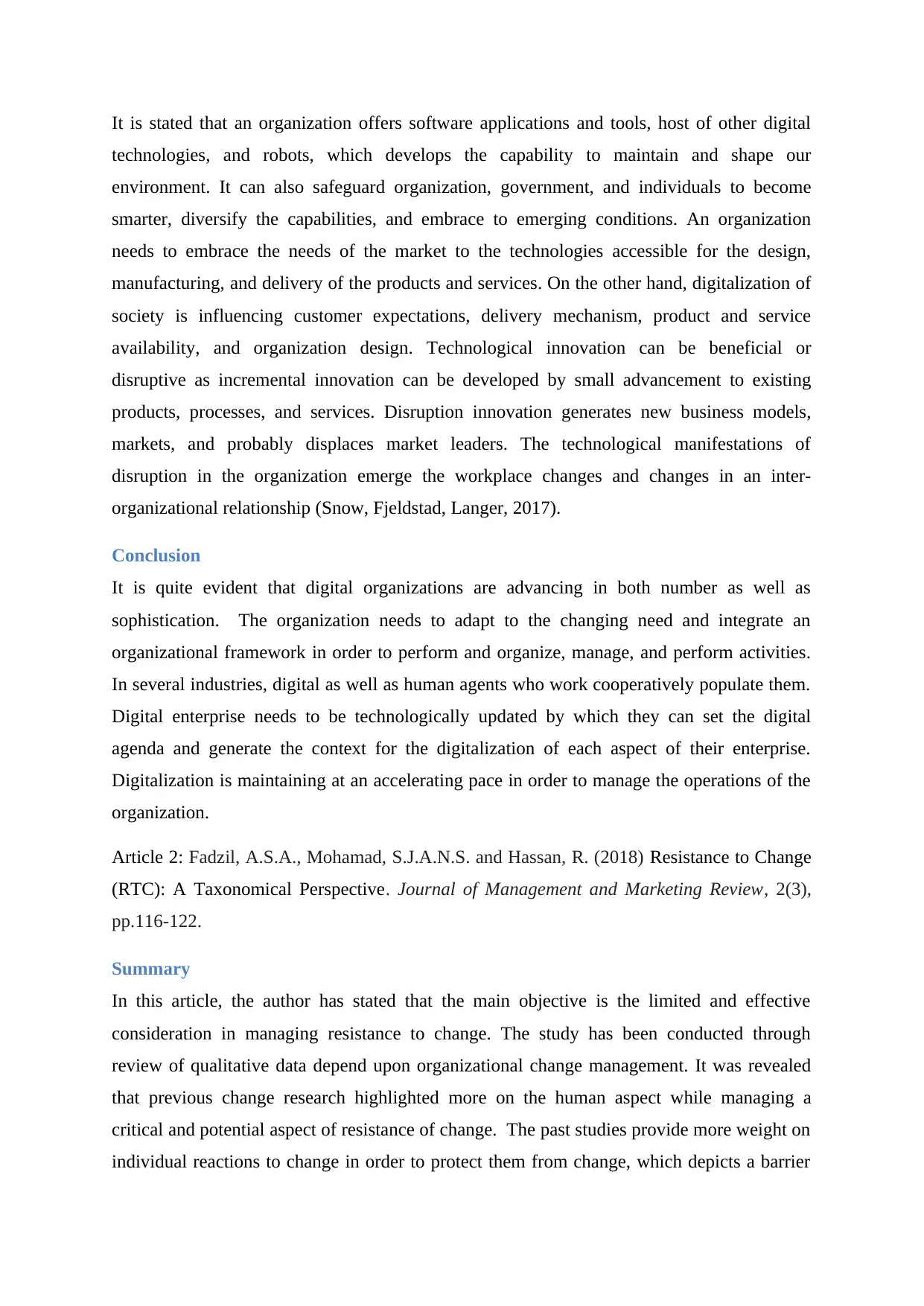
It is stated that an organization offers software applications and tools, host of other digital
technologies, and robots, which develops the capability to maintain and shape our
environment. It can also safeguard organization, government, and individuals to become
smarter, diversify the capabilities, and embrace to emerging conditions. An organization
needs to embrace the needs of the market to the technologies accessible for the design,
manufacturing, and delivery of the products and services. On the other hand, digitalization of
society is influencing customer expectations, delivery mechanism, product and service
availability, and organization design. Technological innovation can be beneficial or
disruptive as incremental innovation can be developed by small advancement to existing
products, processes, and services. Disruption innovation generates new business models,
markets, and probably displaces market leaders. The technological manifestations of
disruption in the organization emerge the workplace changes and changes in an inter-
organizational relationship (Snow, Fjeldstad, Langer, 2017).
Conclusion
It is quite evident that digital organizations are advancing in both number as well as
sophistication. The organization needs to adapt to the changing need and integrate an
organizational framework in order to perform and organize, manage, and perform activities.
In several industries, digital as well as human agents who work cooperatively populate them.
Digital enterprise needs to be technologically updated by which they can set the digital
agenda and generate the context for the digitalization of each aspect of their enterprise.
Digitalization is maintaining at an accelerating pace in order to manage the operations of the
organization.
Article 2: Fadzil, A.S.A., Mohamad, S.J.A.N.S. and Hassan, R. (2018) Resistance to Change
(RTC): A Taxonomical Perspective. Journal of Management and Marketing Review, 2(3),
pp.116-122.
Summary
In this article, the author has stated that the main objective is the limited and effective
consideration in managing resistance to change. The study has been conducted through
review of qualitative data depend upon organizational change management. It was revealed
that previous change research highlighted more on the human aspect while managing a
critical and potential aspect of resistance of change. The past studies provide more weight on
individual reactions to change in order to protect them from change, which depicts a barrier
technologies, and robots, which develops the capability to maintain and shape our
environment. It can also safeguard organization, government, and individuals to become
smarter, diversify the capabilities, and embrace to emerging conditions. An organization
needs to embrace the needs of the market to the technologies accessible for the design,
manufacturing, and delivery of the products and services. On the other hand, digitalization of
society is influencing customer expectations, delivery mechanism, product and service
availability, and organization design. Technological innovation can be beneficial or
disruptive as incremental innovation can be developed by small advancement to existing
products, processes, and services. Disruption innovation generates new business models,
markets, and probably displaces market leaders. The technological manifestations of
disruption in the organization emerge the workplace changes and changes in an inter-
organizational relationship (Snow, Fjeldstad, Langer, 2017).
Conclusion
It is quite evident that digital organizations are advancing in both number as well as
sophistication. The organization needs to adapt to the changing need and integrate an
organizational framework in order to perform and organize, manage, and perform activities.
In several industries, digital as well as human agents who work cooperatively populate them.
Digital enterprise needs to be technologically updated by which they can set the digital
agenda and generate the context for the digitalization of each aspect of their enterprise.
Digitalization is maintaining at an accelerating pace in order to manage the operations of the
organization.
Article 2: Fadzil, A.S.A., Mohamad, S.J.A.N.S. and Hassan, R. (2018) Resistance to Change
(RTC): A Taxonomical Perspective. Journal of Management and Marketing Review, 2(3),
pp.116-122.
Summary
In this article, the author has stated that the main objective is the limited and effective
consideration in managing resistance to change. The study has been conducted through
review of qualitative data depend upon organizational change management. It was revealed
that previous change research highlighted more on the human aspect while managing a
critical and potential aspect of resistance of change. The past studies provide more weight on
individual reactions to change in order to protect them from change, which depicts a barrier
⊘ This is a preview!⊘
Do you want full access?
Subscribe today to unlock all pages.

Trusted by 1+ million students worldwide

from permitting the individual to embrace the change. It is stated that the resistance correlates
with the mind of an individual, which reflects one's responsiveness and willingness to
change, which influences the thinking and behavior of an individual. In addition, there are
several spectrums all are portraying the same consistency, which incorporates a situation into
an unfamiliar or indefinite state.
It is stated that resistance to change has to be a major problem in the failure of an
organization. Similarly, managing resistance to change is an important aspect to identify
whether the organization will achieve success in the future. Thus, the productive way to
manage change profitably is by recognizing the resistance itself. Hence, resistance to change
should be managed successfully and to be given holistic and sufficient consideration by the
management.
Critique
It has been found form the article that resistance to change is been determined as the behavior
to safeguard an individual from the impacts of imagined change. According to Zaltman &
Duncan (2014), it has been stated that it is any action that serves to safeguard the status quo
during the pressure to transform the status quo. Coghlan (1993) stated that change resistance
is a natural as well as normal reaction to change as change distresses with moving from
known to unknown. It has been found from the research that there are several forms in which
resistance to change can be clear. Harvey and Broyles (2010), recorded 20 resistance to
change aspects, which are stated as psychological factors, active and passive resistance
factors, perception factors, and others.
However, it has been quite evident that the majority of derived from the psychological well-
being in the manner the change impacting them. It is being evident from the research that
perception is influenced by individual personal growth and development. In light of the
psychological well-being of the employees' resistance is because of the perceived threats to
their status quo in the direction of loss of pay, integrity, status, autonomy, and ideals. It has
been discovered that change resistance can be initiated if the organization change challenges
the employees' rights and values (Fadzil, Mohamad, and Hassan, 2018).
Conclusion
In conclusion, it has been stated that each employee has its own unique mechanism that
safeguards them from change and allowing them to adapt to the change. Resistance correlates
with the mind of an individual and influences their thinking so they need to give proper
with the mind of an individual, which reflects one's responsiveness and willingness to
change, which influences the thinking and behavior of an individual. In addition, there are
several spectrums all are portraying the same consistency, which incorporates a situation into
an unfamiliar or indefinite state.
It is stated that resistance to change has to be a major problem in the failure of an
organization. Similarly, managing resistance to change is an important aspect to identify
whether the organization will achieve success in the future. Thus, the productive way to
manage change profitably is by recognizing the resistance itself. Hence, resistance to change
should be managed successfully and to be given holistic and sufficient consideration by the
management.
Critique
It has been found form the article that resistance to change is been determined as the behavior
to safeguard an individual from the impacts of imagined change. According to Zaltman &
Duncan (2014), it has been stated that it is any action that serves to safeguard the status quo
during the pressure to transform the status quo. Coghlan (1993) stated that change resistance
is a natural as well as normal reaction to change as change distresses with moving from
known to unknown. It has been found from the research that there are several forms in which
resistance to change can be clear. Harvey and Broyles (2010), recorded 20 resistance to
change aspects, which are stated as psychological factors, active and passive resistance
factors, perception factors, and others.
However, it has been quite evident that the majority of derived from the psychological well-
being in the manner the change impacting them. It is being evident from the research that
perception is influenced by individual personal growth and development. In light of the
psychological well-being of the employees' resistance is because of the perceived threats to
their status quo in the direction of loss of pay, integrity, status, autonomy, and ideals. It has
been discovered that change resistance can be initiated if the organization change challenges
the employees' rights and values (Fadzil, Mohamad, and Hassan, 2018).
Conclusion
In conclusion, it has been stated that each employee has its own unique mechanism that
safeguards them from change and allowing them to adapt to the change. Resistance correlates
with the mind of an individual and influences their thinking so they need to give proper
Paraphrase This Document
Need a fresh take? Get an instant paraphrase of this document with our AI Paraphraser
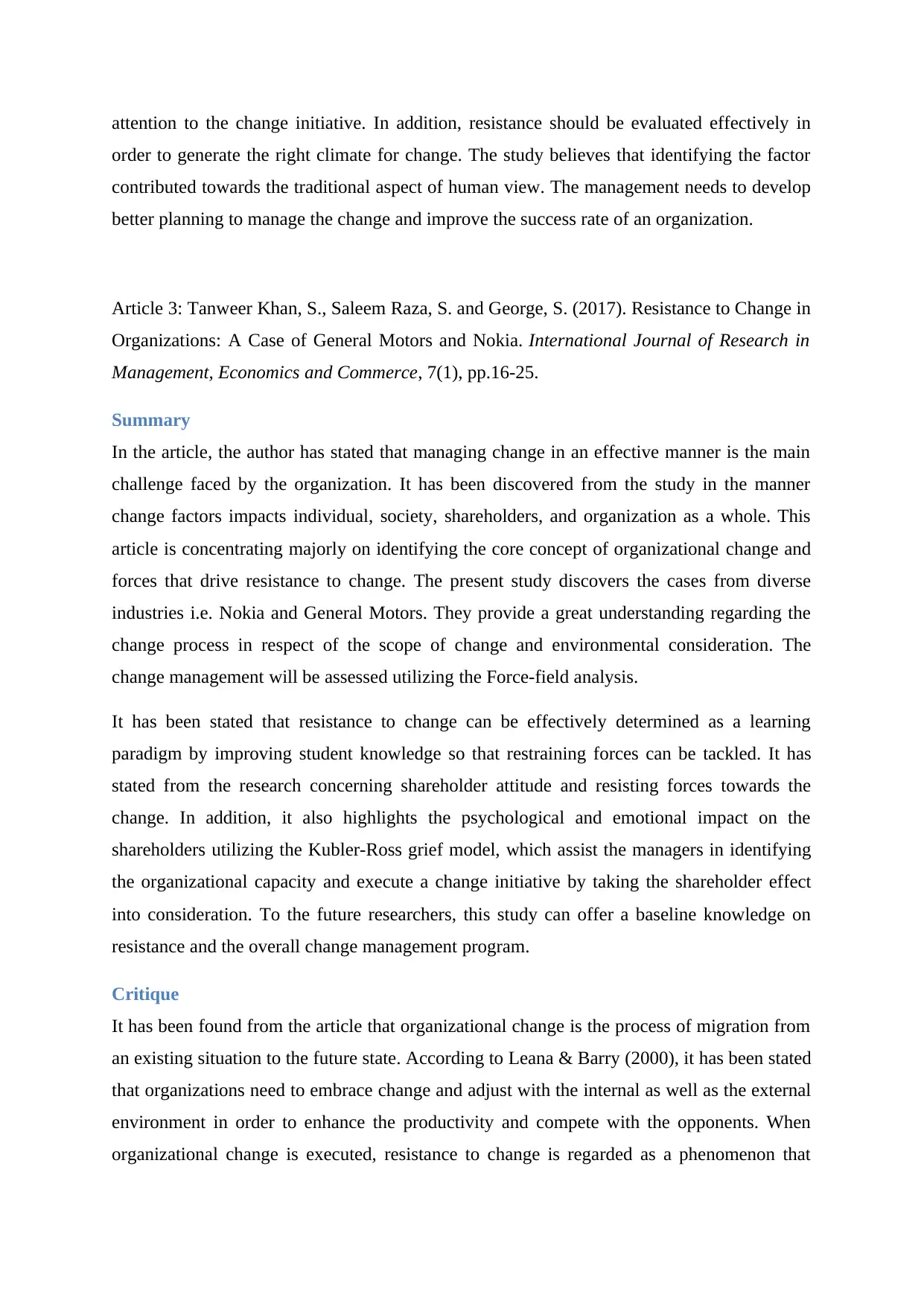
attention to the change initiative. In addition, resistance should be evaluated effectively in
order to generate the right climate for change. The study believes that identifying the factor
contributed towards the traditional aspect of human view. The management needs to develop
better planning to manage the change and improve the success rate of an organization.
Article 3: Tanweer Khan, S., Saleem Raza, S. and George, S. (2017). Resistance to Change in
Organizations: A Case of General Motors and Nokia. International Journal of Research in
Management, Economics and Commerce, 7(1), pp.16-25.
Summary
In the article, the author has stated that managing change in an effective manner is the main
challenge faced by the organization. It has been discovered from the study in the manner
change factors impacts individual, society, shareholders, and organization as a whole. This
article is concentrating majorly on identifying the core concept of organizational change and
forces that drive resistance to change. The present study discovers the cases from diverse
industries i.e. Nokia and General Motors. They provide a great understanding regarding the
change process in respect of the scope of change and environmental consideration. The
change management will be assessed utilizing the Force-field analysis.
It has been stated that resistance to change can be effectively determined as a learning
paradigm by improving student knowledge so that restraining forces can be tackled. It has
stated from the research concerning shareholder attitude and resisting forces towards the
change. In addition, it also highlights the psychological and emotional impact on the
shareholders utilizing the Kubler-Ross grief model, which assist the managers in identifying
the organizational capacity and execute a change initiative by taking the shareholder effect
into consideration. To the future researchers, this study can offer a baseline knowledge on
resistance and the overall change management program.
Critique
It has been found from the article that organizational change is the process of migration from
an existing situation to the future state. According to Leana & Barry (2000), it has been stated
that organizations need to embrace change and adjust with the internal as well as the external
environment in order to enhance the productivity and compete with the opponents. When
organizational change is executed, resistance to change is regarded as a phenomenon that
order to generate the right climate for change. The study believes that identifying the factor
contributed towards the traditional aspect of human view. The management needs to develop
better planning to manage the change and improve the success rate of an organization.
Article 3: Tanweer Khan, S., Saleem Raza, S. and George, S. (2017). Resistance to Change in
Organizations: A Case of General Motors and Nokia. International Journal of Research in
Management, Economics and Commerce, 7(1), pp.16-25.
Summary
In the article, the author has stated that managing change in an effective manner is the main
challenge faced by the organization. It has been discovered from the study in the manner
change factors impacts individual, society, shareholders, and organization as a whole. This
article is concentrating majorly on identifying the core concept of organizational change and
forces that drive resistance to change. The present study discovers the cases from diverse
industries i.e. Nokia and General Motors. They provide a great understanding regarding the
change process in respect of the scope of change and environmental consideration. The
change management will be assessed utilizing the Force-field analysis.
It has been stated that resistance to change can be effectively determined as a learning
paradigm by improving student knowledge so that restraining forces can be tackled. It has
stated from the research concerning shareholder attitude and resisting forces towards the
change. In addition, it also highlights the psychological and emotional impact on the
shareholders utilizing the Kubler-Ross grief model, which assist the managers in identifying
the organizational capacity and execute a change initiative by taking the shareholder effect
into consideration. To the future researchers, this study can offer a baseline knowledge on
resistance and the overall change management program.
Critique
It has been found from the article that organizational change is the process of migration from
an existing situation to the future state. According to Leana & Barry (2000), it has been stated
that organizations need to embrace change and adjust with the internal as well as the external
environment in order to enhance the productivity and compete with the opponents. When
organizational change is executed, resistance to change is regarded as a phenomenon that
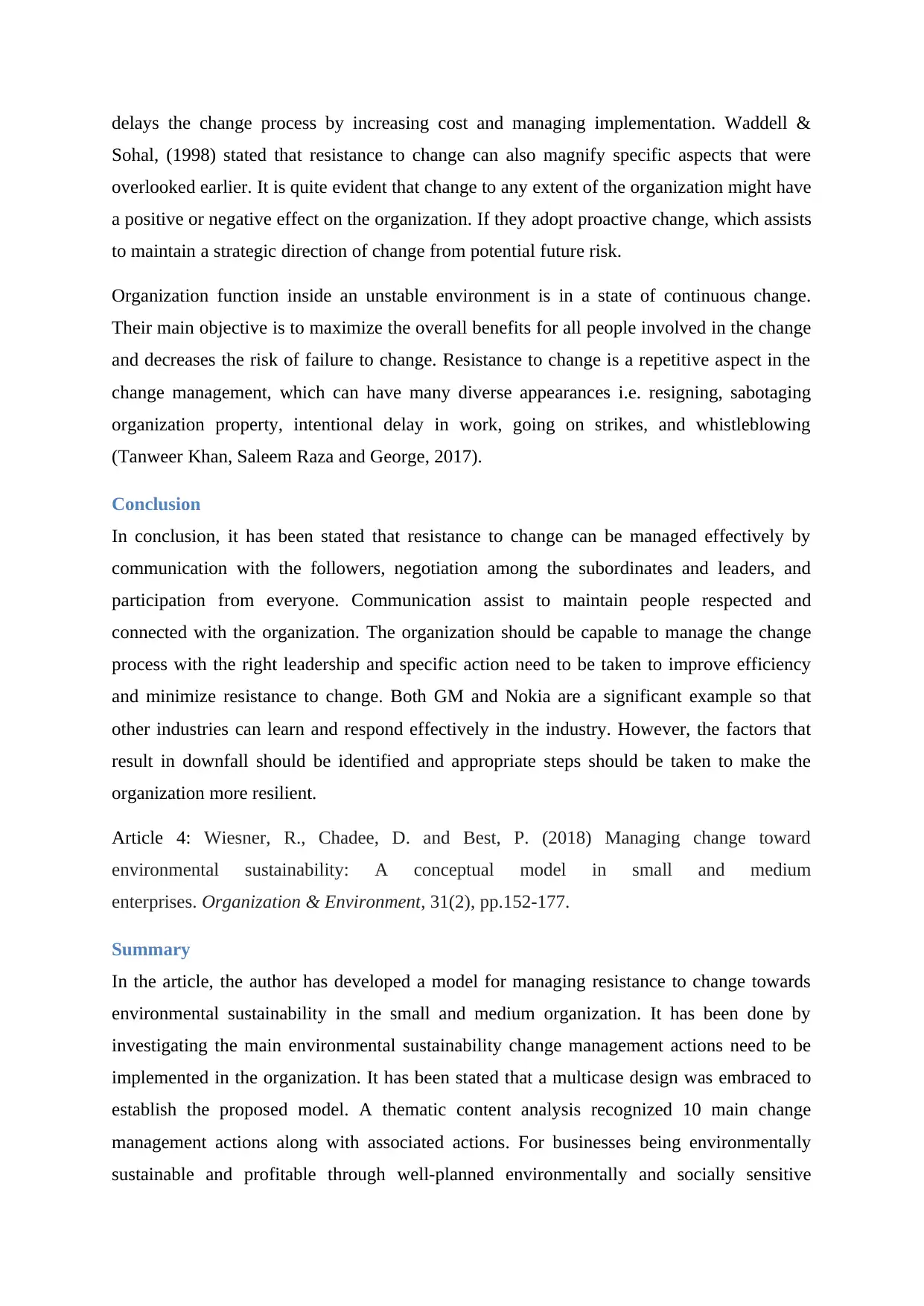
delays the change process by increasing cost and managing implementation. Waddell &
Sohal, (1998) stated that resistance to change can also magnify specific aspects that were
overlooked earlier. It is quite evident that change to any extent of the organization might have
a positive or negative effect on the organization. If they adopt proactive change, which assists
to maintain a strategic direction of change from potential future risk.
Organization function inside an unstable environment is in a state of continuous change.
Their main objective is to maximize the overall benefits for all people involved in the change
and decreases the risk of failure to change. Resistance to change is a repetitive aspect in the
change management, which can have many diverse appearances i.e. resigning, sabotaging
organization property, intentional delay in work, going on strikes, and whistleblowing
(Tanweer Khan, Saleem Raza and George, 2017).
Conclusion
In conclusion, it has been stated that resistance to change can be managed effectively by
communication with the followers, negotiation among the subordinates and leaders, and
participation from everyone. Communication assist to maintain people respected and
connected with the organization. The organization should be capable to manage the change
process with the right leadership and specific action need to be taken to improve efficiency
and minimize resistance to change. Both GM and Nokia are a significant example so that
other industries can learn and respond effectively in the industry. However, the factors that
result in downfall should be identified and appropriate steps should be taken to make the
organization more resilient.
Article 4: Wiesner, R., Chadee, D. and Best, P. (2018) Managing change toward
environmental sustainability: A conceptual model in small and medium
enterprises. Organization & Environment, 31(2), pp.152-177.
Summary
In the article, the author has developed a model for managing resistance to change towards
environmental sustainability in the small and medium organization. It has been done by
investigating the main environmental sustainability change management actions need to be
implemented in the organization. It has been stated that a multicase design was embraced to
establish the proposed model. A thematic content analysis recognized 10 main change
management actions along with associated actions. For businesses being environmentally
sustainable and profitable through well-planned environmentally and socially sensitive
Sohal, (1998) stated that resistance to change can also magnify specific aspects that were
overlooked earlier. It is quite evident that change to any extent of the organization might have
a positive or negative effect on the organization. If they adopt proactive change, which assists
to maintain a strategic direction of change from potential future risk.
Organization function inside an unstable environment is in a state of continuous change.
Their main objective is to maximize the overall benefits for all people involved in the change
and decreases the risk of failure to change. Resistance to change is a repetitive aspect in the
change management, which can have many diverse appearances i.e. resigning, sabotaging
organization property, intentional delay in work, going on strikes, and whistleblowing
(Tanweer Khan, Saleem Raza and George, 2017).
Conclusion
In conclusion, it has been stated that resistance to change can be managed effectively by
communication with the followers, negotiation among the subordinates and leaders, and
participation from everyone. Communication assist to maintain people respected and
connected with the organization. The organization should be capable to manage the change
process with the right leadership and specific action need to be taken to improve efficiency
and minimize resistance to change. Both GM and Nokia are a significant example so that
other industries can learn and respond effectively in the industry. However, the factors that
result in downfall should be identified and appropriate steps should be taken to make the
organization more resilient.
Article 4: Wiesner, R., Chadee, D. and Best, P. (2018) Managing change toward
environmental sustainability: A conceptual model in small and medium
enterprises. Organization & Environment, 31(2), pp.152-177.
Summary
In the article, the author has developed a model for managing resistance to change towards
environmental sustainability in the small and medium organization. It has been done by
investigating the main environmental sustainability change management actions need to be
implemented in the organization. It has been stated that a multicase design was embraced to
establish the proposed model. A thematic content analysis recognized 10 main change
management actions along with associated actions. For businesses being environmentally
sustainable and profitable through well-planned environmentally and socially sensitive
⊘ This is a preview!⊘
Do you want full access?
Subscribe today to unlock all pages.

Trusted by 1+ million students worldwide
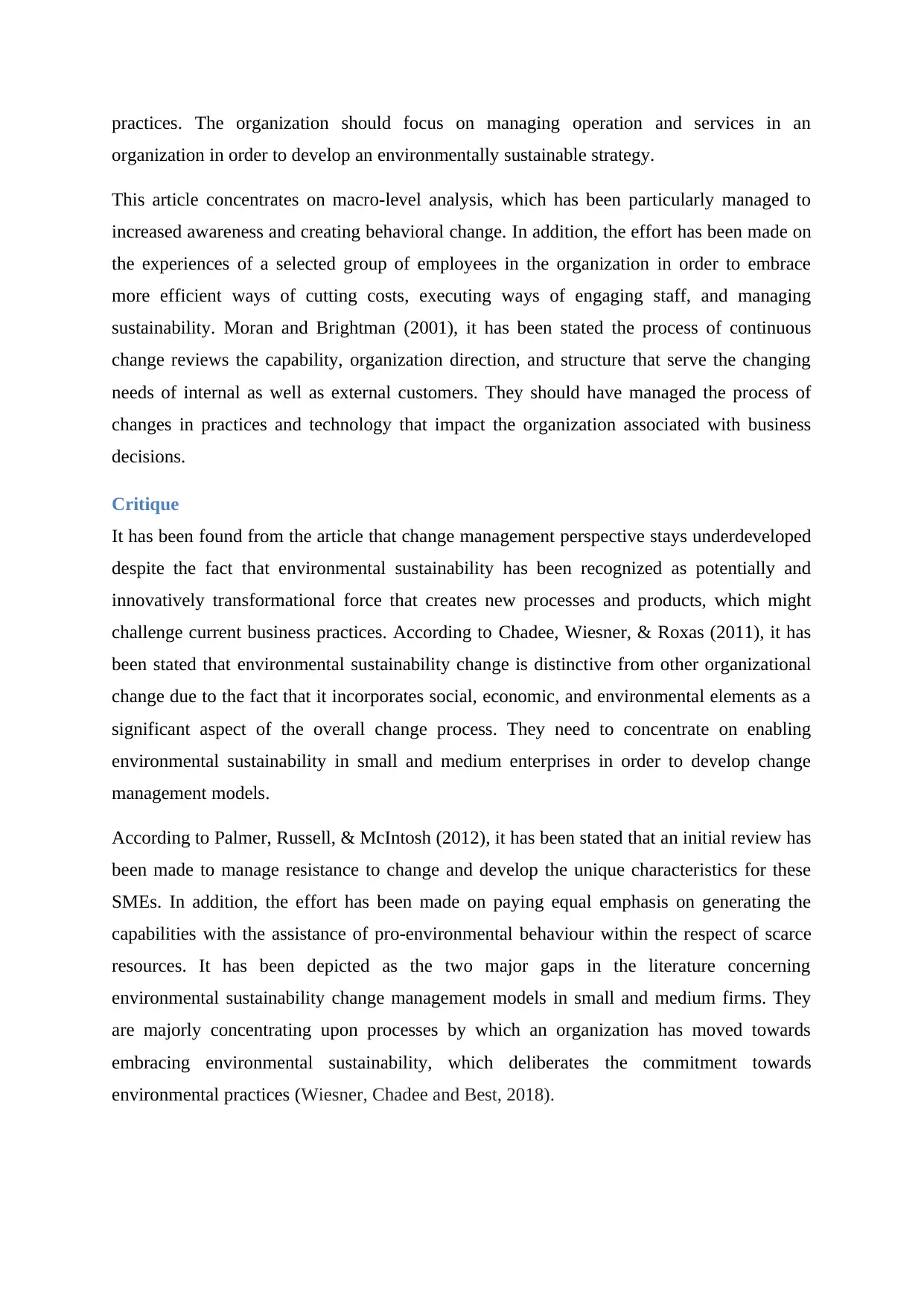
practices. The organization should focus on managing operation and services in an
organization in order to develop an environmentally sustainable strategy.
This article concentrates on macro-level analysis, which has been particularly managed to
increased awareness and creating behavioral change. In addition, the effort has been made on
the experiences of a selected group of employees in the organization in order to embrace
more efficient ways of cutting costs, executing ways of engaging staff, and managing
sustainability. Moran and Brightman (2001), it has been stated the process of continuous
change reviews the capability, organization direction, and structure that serve the changing
needs of internal as well as external customers. They should have managed the process of
changes in practices and technology that impact the organization associated with business
decisions.
Critique
It has been found from the article that change management perspective stays underdeveloped
despite the fact that environmental sustainability has been recognized as potentially and
innovatively transformational force that creates new processes and products, which might
challenge current business practices. According to Chadee, Wiesner, & Roxas (2011), it has
been stated that environmental sustainability change is distinctive from other organizational
change due to the fact that it incorporates social, economic, and environmental elements as a
significant aspect of the overall change process. They need to concentrate on enabling
environmental sustainability in small and medium enterprises in order to develop change
management models.
According to Palmer, Russell, & McIntosh (2012), it has been stated that an initial review has
been made to manage resistance to change and develop the unique characteristics for these
SMEs. In addition, the effort has been made on paying equal emphasis on generating the
capabilities with the assistance of pro-environmental behaviour within the respect of scarce
resources. It has been depicted as the two major gaps in the literature concerning
environmental sustainability change management models in small and medium firms. They
are majorly concentrating upon processes by which an organization has moved towards
embracing environmental sustainability, which deliberates the commitment towards
environmental practices (Wiesner, Chadee and Best, 2018).
organization in order to develop an environmentally sustainable strategy.
This article concentrates on macro-level analysis, which has been particularly managed to
increased awareness and creating behavioral change. In addition, the effort has been made on
the experiences of a selected group of employees in the organization in order to embrace
more efficient ways of cutting costs, executing ways of engaging staff, and managing
sustainability. Moran and Brightman (2001), it has been stated the process of continuous
change reviews the capability, organization direction, and structure that serve the changing
needs of internal as well as external customers. They should have managed the process of
changes in practices and technology that impact the organization associated with business
decisions.
Critique
It has been found from the article that change management perspective stays underdeveloped
despite the fact that environmental sustainability has been recognized as potentially and
innovatively transformational force that creates new processes and products, which might
challenge current business practices. According to Chadee, Wiesner, & Roxas (2011), it has
been stated that environmental sustainability change is distinctive from other organizational
change due to the fact that it incorporates social, economic, and environmental elements as a
significant aspect of the overall change process. They need to concentrate on enabling
environmental sustainability in small and medium enterprises in order to develop change
management models.
According to Palmer, Russell, & McIntosh (2012), it has been stated that an initial review has
been made to manage resistance to change and develop the unique characteristics for these
SMEs. In addition, the effort has been made on paying equal emphasis on generating the
capabilities with the assistance of pro-environmental behaviour within the respect of scarce
resources. It has been depicted as the two major gaps in the literature concerning
environmental sustainability change management models in small and medium firms. They
are majorly concentrating upon processes by which an organization has moved towards
embracing environmental sustainability, which deliberates the commitment towards
environmental practices (Wiesner, Chadee and Best, 2018).
Paraphrase This Document
Need a fresh take? Get an instant paraphrase of this document with our AI Paraphraser
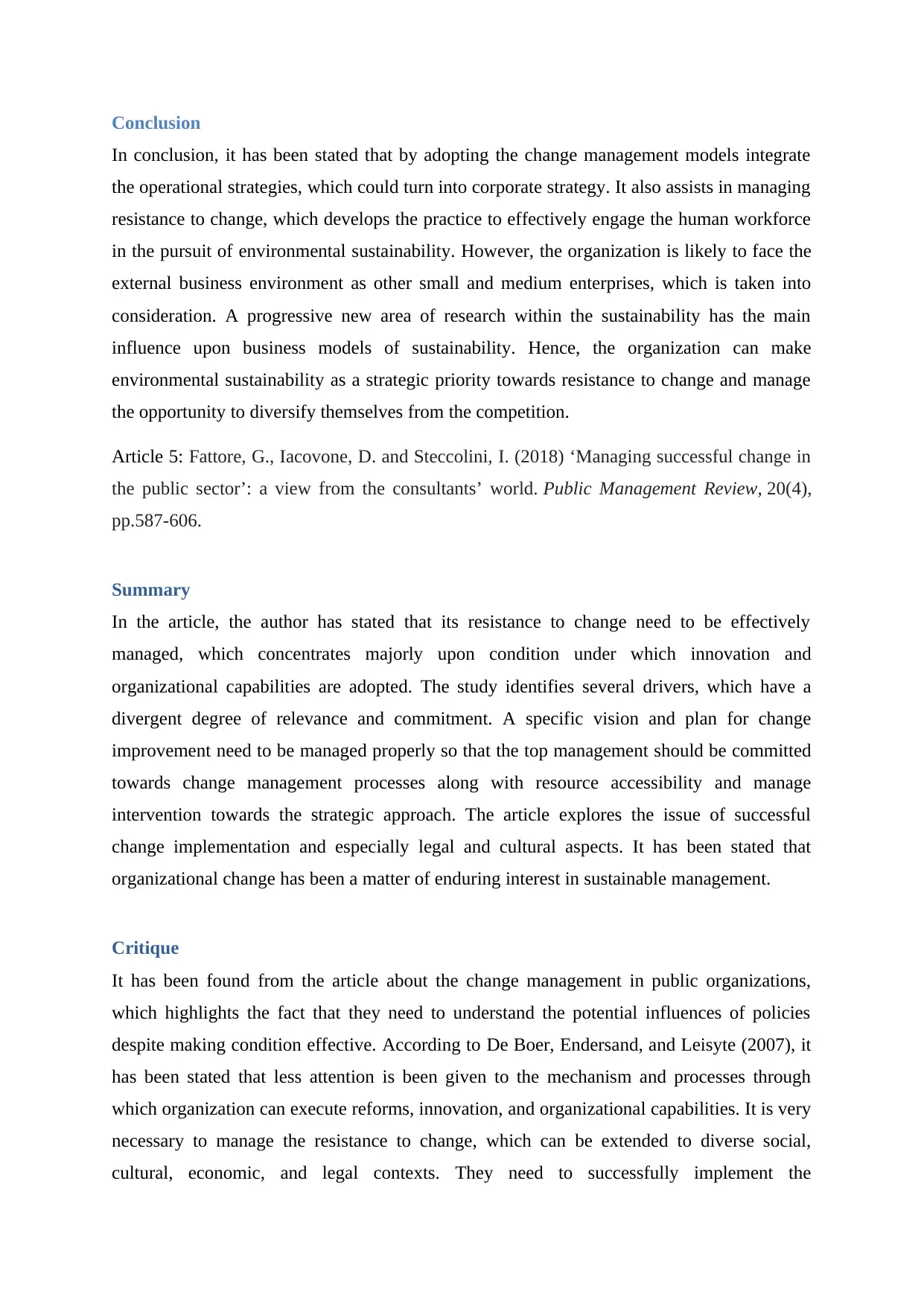
Conclusion
In conclusion, it has been stated that by adopting the change management models integrate
the operational strategies, which could turn into corporate strategy. It also assists in managing
resistance to change, which develops the practice to effectively engage the human workforce
in the pursuit of environmental sustainability. However, the organization is likely to face the
external business environment as other small and medium enterprises, which is taken into
consideration. A progressive new area of research within the sustainability has the main
influence upon business models of sustainability. Hence, the organization can make
environmental sustainability as a strategic priority towards resistance to change and manage
the opportunity to diversify themselves from the competition.
Article 5: Fattore, G., Iacovone, D. and Steccolini, I. (2018) ‘Managing successful change in
the public sector’: a view from the consultants’ world. Public Management Review, 20(4),
pp.587-606.
Summary
In the article, the author has stated that its resistance to change need to be effectively
managed, which concentrates majorly upon condition under which innovation and
organizational capabilities are adopted. The study identifies several drivers, which have a
divergent degree of relevance and commitment. A specific vision and plan for change
improvement need to be managed properly so that the top management should be committed
towards change management processes along with resource accessibility and manage
intervention towards the strategic approach. The article explores the issue of successful
change implementation and especially legal and cultural aspects. It has been stated that
organizational change has been a matter of enduring interest in sustainable management.
Critique
It has been found from the article about the change management in public organizations,
which highlights the fact that they need to understand the potential influences of policies
despite making condition effective. According to De Boer, Endersand, and Leisyte (2007), it
has been stated that less attention is been given to the mechanism and processes through
which organization can execute reforms, innovation, and organizational capabilities. It is very
necessary to manage the resistance to change, which can be extended to diverse social,
cultural, economic, and legal contexts. They need to successfully implement the
In conclusion, it has been stated that by adopting the change management models integrate
the operational strategies, which could turn into corporate strategy. It also assists in managing
resistance to change, which develops the practice to effectively engage the human workforce
in the pursuit of environmental sustainability. However, the organization is likely to face the
external business environment as other small and medium enterprises, which is taken into
consideration. A progressive new area of research within the sustainability has the main
influence upon business models of sustainability. Hence, the organization can make
environmental sustainability as a strategic priority towards resistance to change and manage
the opportunity to diversify themselves from the competition.
Article 5: Fattore, G., Iacovone, D. and Steccolini, I. (2018) ‘Managing successful change in
the public sector’: a view from the consultants’ world. Public Management Review, 20(4),
pp.587-606.
Summary
In the article, the author has stated that its resistance to change need to be effectively
managed, which concentrates majorly upon condition under which innovation and
organizational capabilities are adopted. The study identifies several drivers, which have a
divergent degree of relevance and commitment. A specific vision and plan for change
improvement need to be managed properly so that the top management should be committed
towards change management processes along with resource accessibility and manage
intervention towards the strategic approach. The article explores the issue of successful
change implementation and especially legal and cultural aspects. It has been stated that
organizational change has been a matter of enduring interest in sustainable management.
Critique
It has been found from the article about the change management in public organizations,
which highlights the fact that they need to understand the potential influences of policies
despite making condition effective. According to De Boer, Endersand, and Leisyte (2007), it
has been stated that less attention is been given to the mechanism and processes through
which organization can execute reforms, innovation, and organizational capabilities. It is very
necessary to manage the resistance to change, which can be extended to diverse social,
cultural, economic, and legal contexts. They need to successfully implement the
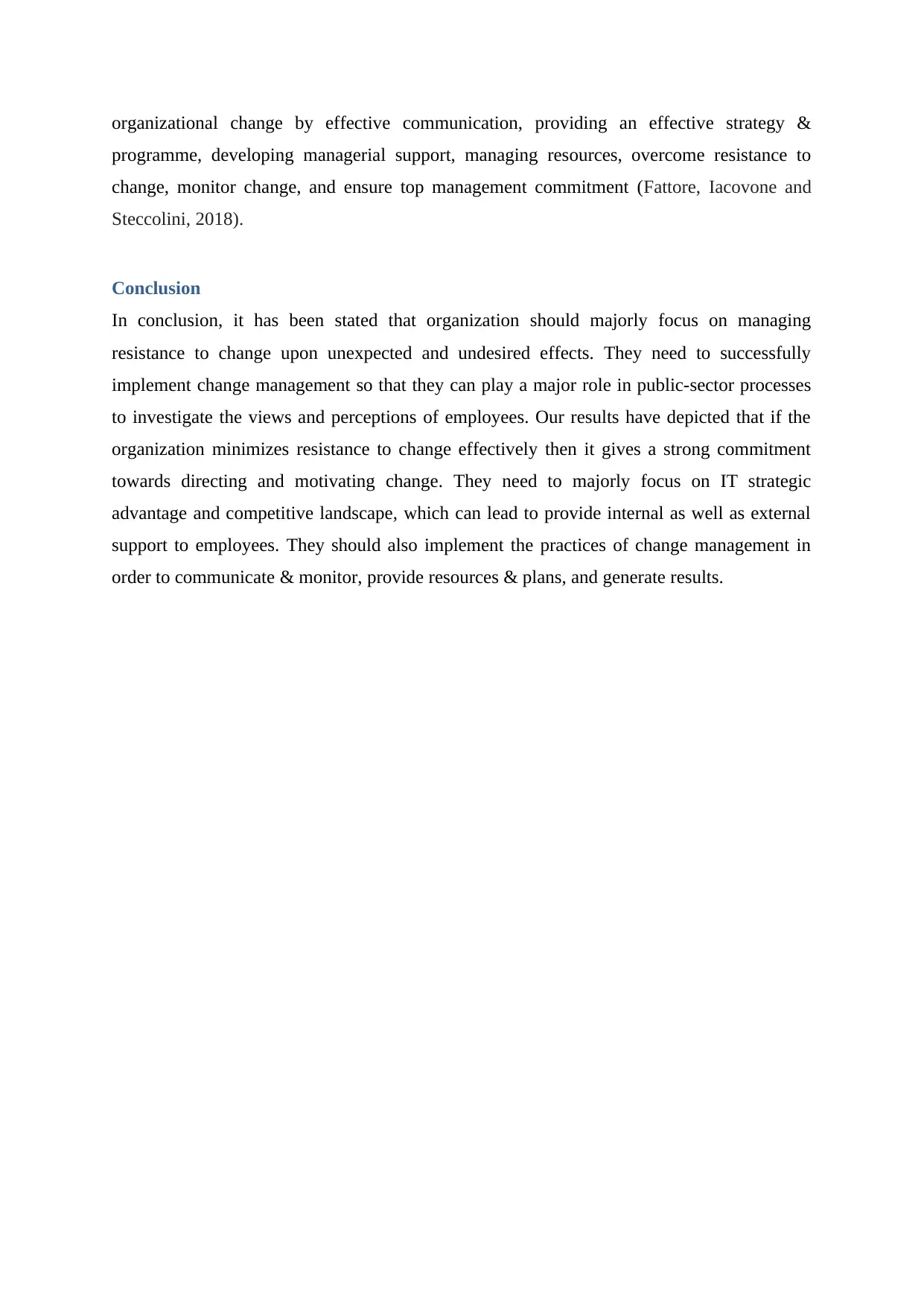
organizational change by effective communication, providing an effective strategy &
programme, developing managerial support, managing resources, overcome resistance to
change, monitor change, and ensure top management commitment (Fattore, Iacovone and
Steccolini, 2018).
Conclusion
In conclusion, it has been stated that organization should majorly focus on managing
resistance to change upon unexpected and undesired effects. They need to successfully
implement change management so that they can play a major role in public-sector processes
to investigate the views and perceptions of employees. Our results have depicted that if the
organization minimizes resistance to change effectively then it gives a strong commitment
towards directing and motivating change. They need to majorly focus on IT strategic
advantage and competitive landscape, which can lead to provide internal as well as external
support to employees. They should also implement the practices of change management in
order to communicate & monitor, provide resources & plans, and generate results.
programme, developing managerial support, managing resources, overcome resistance to
change, monitor change, and ensure top management commitment (Fattore, Iacovone and
Steccolini, 2018).
Conclusion
In conclusion, it has been stated that organization should majorly focus on managing
resistance to change upon unexpected and undesired effects. They need to successfully
implement change management so that they can play a major role in public-sector processes
to investigate the views and perceptions of employees. Our results have depicted that if the
organization minimizes resistance to change effectively then it gives a strong commitment
towards directing and motivating change. They need to majorly focus on IT strategic
advantage and competitive landscape, which can lead to provide internal as well as external
support to employees. They should also implement the practices of change management in
order to communicate & monitor, provide resources & plans, and generate results.
⊘ This is a preview!⊘
Do you want full access?
Subscribe today to unlock all pages.

Trusted by 1+ million students worldwide
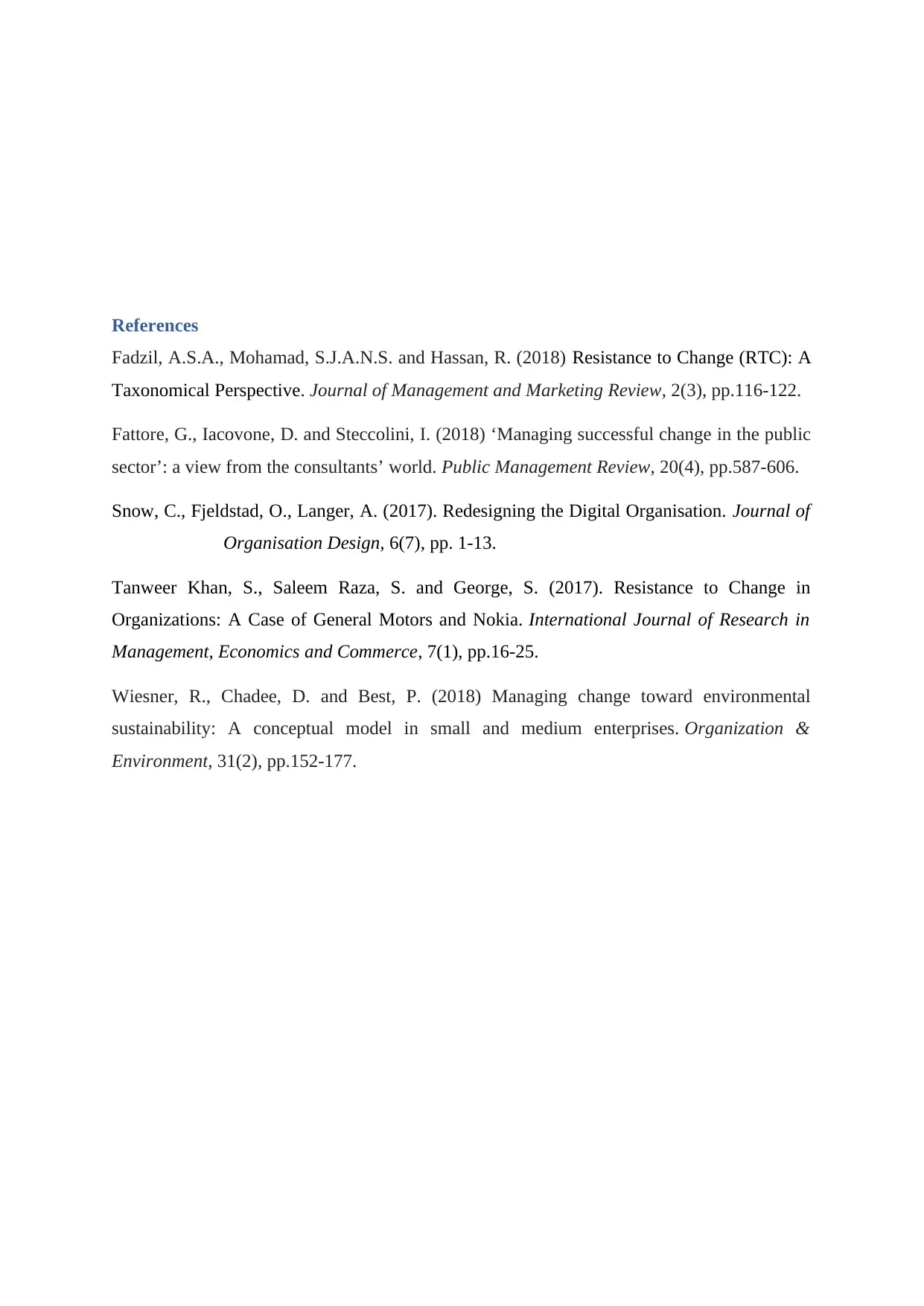
References
Fadzil, A.S.A., Mohamad, S.J.A.N.S. and Hassan, R. (2018) Resistance to Change (RTC): A
Taxonomical Perspective. Journal of Management and Marketing Review, 2(3), pp.116-122.
Fattore, G., Iacovone, D. and Steccolini, I. (2018) ‘Managing successful change in the public
sector’: a view from the consultants’ world. Public Management Review, 20(4), pp.587-606.
Snow, C., Fjeldstad, O., Langer, A. (2017). Redesigning the Digital Organisation. Journal of
Organisation Design, 6(7), pp. 1-13.
Tanweer Khan, S., Saleem Raza, S. and George, S. (2017). Resistance to Change in
Organizations: A Case of General Motors and Nokia. International Journal of Research in
Management, Economics and Commerce, 7(1), pp.16-25.
Wiesner, R., Chadee, D. and Best, P. (2018) Managing change toward environmental
sustainability: A conceptual model in small and medium enterprises. Organization &
Environment, 31(2), pp.152-177.
Fadzil, A.S.A., Mohamad, S.J.A.N.S. and Hassan, R. (2018) Resistance to Change (RTC): A
Taxonomical Perspective. Journal of Management and Marketing Review, 2(3), pp.116-122.
Fattore, G., Iacovone, D. and Steccolini, I. (2018) ‘Managing successful change in the public
sector’: a view from the consultants’ world. Public Management Review, 20(4), pp.587-606.
Snow, C., Fjeldstad, O., Langer, A. (2017). Redesigning the Digital Organisation. Journal of
Organisation Design, 6(7), pp. 1-13.
Tanweer Khan, S., Saleem Raza, S. and George, S. (2017). Resistance to Change in
Organizations: A Case of General Motors and Nokia. International Journal of Research in
Management, Economics and Commerce, 7(1), pp.16-25.
Wiesner, R., Chadee, D. and Best, P. (2018) Managing change toward environmental
sustainability: A conceptual model in small and medium enterprises. Organization &
Environment, 31(2), pp.152-177.
1 out of 10
Related Documents
Your All-in-One AI-Powered Toolkit for Academic Success.
+13062052269
info@desklib.com
Available 24*7 on WhatsApp / Email
![[object Object]](/_next/static/media/star-bottom.7253800d.svg)
Unlock your academic potential
Copyright © 2020–2025 A2Z Services. All Rights Reserved. Developed and managed by ZUCOL.





